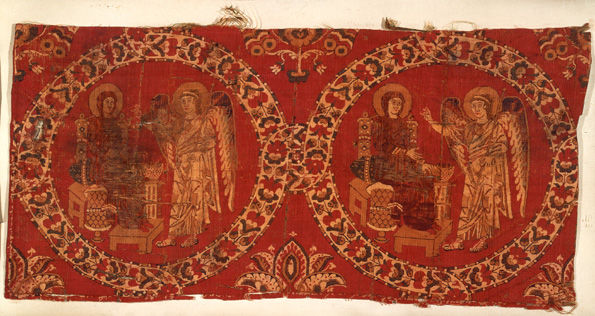Annunciation, 8th–9th century. Made in Alexandria or Egypt, Syria, Constantinople (?). Weft-faced compound twill (samit) in polychrome silk. Vatican Museums, Vatican City (61231)
The red Annunciation silk depicts the seated Virgin dressed in royal purple, receiving a message from the angel Gabriel, encircled by floral medallions referencing a jeweled garden. The fragment is believed to be part of the same textile as a Nativity scene that survives at the Vatican.1 Both fragments include jeweled medallions with floral motifs encircling the Biblical scene, in which the figures are modeled and the faces have detailed expressions. Though the fragment was discovered lining a reliquary casket believed to house the sandals of Christ, the delicacy of the design and fineness of the silk suggest that it may have been used as a garment.
The Byzantine tradition of donning garments with figural designs dates back to the Late Antique and Early Christian periods, when clothing with Christian and non-Christian figural images was intended to protect the wearer from harm. The later date of this piece (eighth to ninth century) may point to a renaissance of figural design with the same imagery following the second period of iconoclasm.
The inherent value of this textile derives partly from its materials, but mostly from the complexity and superiority of its execution. It was created on a drawloom, requiring an advanced figure-harness mechanism to control the execution of the pattern. One of the most technically advanced examples of its kind from the middle Byzantine period, this silk is likely to have been produced in an imperial workshop, where weavers had the time and resources to render the complex design.
[1] Thomas, Thelma K. "Annunciation," Byzantium and Islam: Age of Transition, 7th–9th centuries. Ed. Helen C. Evans. (New Haven: Yale University Press, 2012), 152.
Further Reading
Maguire, Henry. "Garments Pleasing to God: The Significance of Domestic Textile Designs in the Early Byzantine Period." Dumbarton Oaks Papers, Vol. 44 (1990), 215–224.
Muthesius, Anna. Byzantine Silk Weaving: A.D. 400–A.D. 600. Vienna: Verlag Fassbaender, 1997.
Thomas, Thelma K. "Silks," Byzantium and Islam: Age of Transition, 7th–9th centuries. Ed. Helen C. Evans. (New Haven: Yale University Press, 2012), 160-161.
